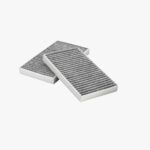MEEC TOOLS POLISHING MACHINE 1100 W User Manual


3601 E. 34th St. Tucson, AZ 85713 USA Tel. +1 520-882-6598 Fax +1 520-882-6599 email: pace@metallographic.com Web: http://www.metallographic.com
Equipment Type: 8 and 10-inch diameter Single Grinder / Polisher
Model: NANO 1000T Speed (rpm)0-1000 rpm
Electrical Requirements: 110 / 220 Volts (single-phase input) (Power converted to 3-phase for motor – higher torque)
Frequency: 50/60 Hz
Motor Horsepower: 1 hp (750 W)
Manual Revision Date: April 2014
Please read this instruction manual carefully and follow all installation, operating and safety guidelines.
WARRANTY
Terms and Conditions applying to all PACE Technologies Products
1. LIMITED WARRANTY AND DISCLAIMER:
PACE Technologies Products are warranted for one year from the purchase date to be free from defects in material and workmanship under correct use, normal operating conditions, and proper application. PACE Technologies obligation under this warranty shall be limited to the repair or exchange, at PACE Technologies option, of any PACE Technologies Product or part which proves to be defective as provided herein. PACE Technologies reserves the right to either inspect the product at Buyer’s location or require it to be returned to the factory for inspection. Buyer is responsible for freight to and from factory on all warranty claims. The above warranty does not extend to goods damaged or subjected to accident, abuse or misuse after release from PACE Technologies warehouse, nor goods altered or repaired by anyone other than specifically authorized PACE Technologies representatives. PACE Technologies shall not in any way be responsible for the consequences of any alteration, modification or misuse unless previously approved in writing by an officer of PACE Technologies.
PACE TECHNOLOGIES MAKES NO EXPRESS WARRANTIES OTHER THAN THOSE WHICH ARE SPECIFICALLY DESCRIBED HEREIN. Any description of the goods sold hereunder, including any reference to Buyer’s specifications and any description in catalogs, circulars and other written material published by PACE Technologies, is the sole purpose of identifying such goods and shall not create an express warranty that the goods shall conform to such description.
THIS WARRANTY IS EXPRESSLY IN LIEU OF ALL OTHER WARRANTIES, EXPRESSED OR IMPLIED. THERE ARE NO IMPLIED WARRANTIES OF MECHANTABILITY OR FITNESS FOR PARTICULAR PURPOSE. THIS WARRANTY STATES PACE TECHNOLOGIES ENTIRE AND EXCLUSIVE LIABILITY AND BUYER’S EXCLUSIVE REMEDY FOR ANY CLAIM FOR DAMAGES IN CONNECTIONS WITH PACE TECHNOLOGIES PRODUCTS. PACE TECHNOLOGIES WILL IN NO EVENT BE LIABLE FOR INCIDENTAL OR CONSEQUENTIAL DAMAGES WHATSOEVER, NOR FOR ANY SUM IN EXCESS OF THE PURCHASE PRICE.
2. LIABILITY CAP:
PACE Technologies maximum aggregate liability for loss and damage arising under, resulting from or in connection with the supply or use of the Equipment and Consumables provided under this purchase, or from the performance or breach of any obligation (s) imposed hereunder, whether such liability arises from any one or more claims or actions for breach of contract, tort, (including negligence), delayed completion, warranty, indemnity, strict liability or otherwise, unless otherwise limited by the terms hereof, shall be limited to one hundred percent (100%) of the purchase price.
3. DELIVERY:
Customer assumes and shall bear the risk of all loss or damage to the Products from every cause whatsoever, whether or not insured, and title to such Products shall pass to Customer upon PACE Technologies delivery of the Products to the common carrier of Pace Technologies choice, or the carrier specified in writing by Customer, for shipment to Customer. Any claims for breakage, loss, delay, or damage shall be made to the carrier by the Customer and Pace Technologies will render customer reasonable assistance in prosecuting such claims.
4. ACCEPTANCE:
Customer shall inspect the Products promptly upon receipt of delivery. Unless customer objects in writing within thirty (30) business days thereafter, customer shall be deemed to have accepted the Products. All claims for damages, errors, or shortage in Products delivered shall be made by Customer in writing within such five (5) business day period. Failure to make any claim timely shall constitute acceptance of the Products.
5. PAYMENT:
Customer agrees to provide timely payment for the Products in accordance with the terms of payment set forth on the reverse side hereof or in any proposal submitted herewith. If any payment is not paid on or before its due date, Customer shall pay interest on such late payment from the due date until paid at the lesser of 12% per annum or the maximum rate allowed by law.
6. DEFAULT:
If Buyer is in default (including, but not limited to, the failure by Buyer to pay all amounts due and payable to Seller) under the work or purchase order or any other agreement between Buyer and Seller, Buyer’s rights under the warranty shall be suspended during any period of such default and the original warranty period will not be extended beyond its original expiration date despite such suspension of warranty rights.
7. MISCELLANEOUS PROVISIONS:
This agreement has been made in and shall be governed by the laws of the State of Arizona. These terms and conditions and the description of the Products on the reverse side hereof or in any proposal submitted herewith constitute the entire agreement and understanding of the parties with respect to this sale and supersede all prior and contemporaneous agreements or understandings, inducements or representations, expressed or implied, written or oral, between the parties with respect hereto. Any term or provision of this Agreement may be amended, and any observance of any term of this Agreement may be waived, only by a writing signed by the party to be bounds. The waiver by a party of any breach shall not be deemed to constitute a waiver of any other breach. Should suit be brought on this Agreement, the prevailing party shall be entitled to recover its reasonable attorneys’ fees and other costs of suit including costs and attorneys’ fees incurred on appeal or in collection of any judgment.
Product Description
1. General Description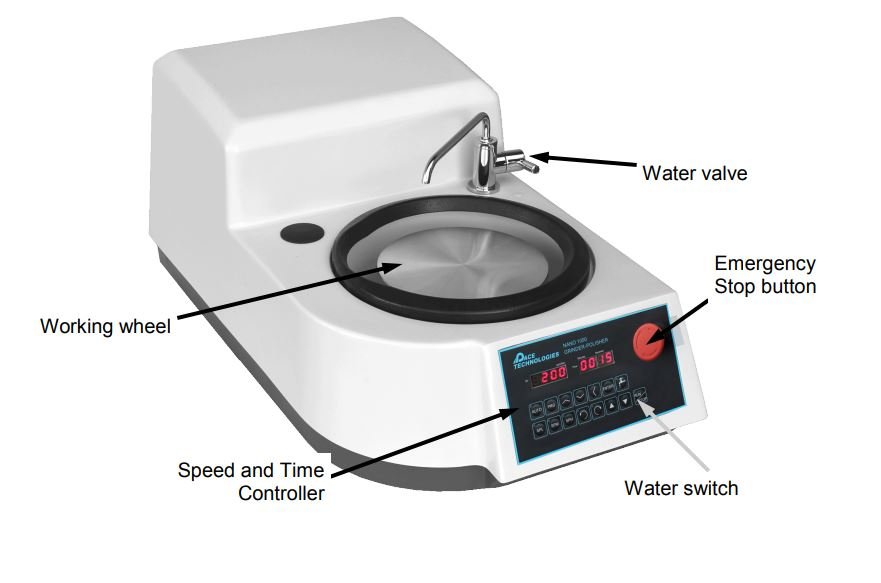
The NANO 1000T is a 8 or 12-inch single wheel grinding/ polishing machine for manual wet grinding or polishing of metallographic specimens.
The NANO 1000T is a variable speed (0-1000 rpm) with three programmable fast speed buttons (approx. 100, 200 and 300 rpm) polisher.
2. Technical Specifications
Electrical specifications: 110 / 220V (50/60 Hz) (single phase input – motor runs on 3-phase power for more torque)
Working wheel: 8-inch (200 mm) or 10-inch (250 mm) diameter
Motor power: 1 hp (750 W)
Polishing base speed: 0 to 1000 rpm variable speed (20 rpm increments). Fast speed buttons pre-programmed for 100, 200 and 300 rpm)
Weight: Approx. 102 lbs (46 kg)
Dimensions (WxHxD): Approx. 14” x 10” x 23” (350 mm x 260 mm x 580 mm)
Working temperature: 32° – 100°F (0 – 40°C)
Shipping temperature: 32° – 100°F (0 – 40°C)
Storage temperature: 32° – 100°F (0 – 40°C)
Maximum diameter sample 1/3 diameter of working wheel
3. Mechanical Schematic
Note: Installation of the NANO 1000T should be on a flat sturdy surface, with easy access to drain, water and electrical connections.
4. Features
The NANO 1000T is equipped with a powerful motor, connected to the polishing wheel through a maintenance-free V-belt.
Unpacking, Shipping and Installation
1. Unpacking
Unit is delivered in a box. Unpack and check for completeness of parts.
Measures WxHxD:
Weight: Varies, depending upon model (approximately ).
2. Shipping
When moving box, lift from bottom.
 Caution: Heavy equipment. Take care to avoid bodily injury.
Caution: Heavy equipment. Take care to avoid bodily injury.
3. Installation
! Install unit carefully! Improper installation voids warranty.
The NANO 1200 should be placed on a flat stable surface.
Connect to air, water supply, drain and electrical connections.
After water, drain and electrical connections are completed, the system is ready for operation by activating the main power switch.
External water supply: The water supply line requires a 1/4-inch compression fitting. It is recommended that the water supply be turned off when the unit is not in use. Inlet water should be clean and contamination-free to extend the life and performance of the systems.
Electrical connection: Connect six-foot electrical power cable to source.
Note: Inspect the operating voltage on the name plate.
Safety Guidelines
1. Warning Sign
! This sign points to special safety features on the machine.
2. Safety Precautions
! Careful attention to this instruction manual and the recommended safety guidelines is essential for the safe operation of the NANO 1000T.
! Proper operator training is required for operation of the NANO 1000T. Any unauthorized mechanical and electrical change, as well as improper operation, voids all warranty claims. All service issues need to be reported to the manufacturer / supplier.
! Operate unit as specified in this manual.
! Disconnect power before opening unit.
! Do not leave any specimen or other parts on the working wheel.
! Ensure that the air slots on polishing base are not obstructed.
! When unit is not in use turn off water.
! Securely hold the sample, preferably with two hands.
3. Emergency Statement
The NANO 1000T polisher has been designed for polishing metallographic specimens up to 2- inch diameter. DO NOT GRIND OR POLISH oversize sample (greater then 1/3 diameter of working wheel. Always follow proper operational guidelines and avoid contact with moving parts, lubricants and abrasives. Seek appropriate medical care for cutting injuries.
4. Safety Test
! Examine and verify that the NANO 1000T safety devices and operating performance are in good working condition prior to use. The following safety check is considered important:
Emergency stop switch
Test: Activate main switch. Depress emergency stop switch.
Proper
Response: Machine powers down.
Malfunction: Machine does not lose power.
Corrective
measure: If system does not power down, disconnect power supply cord and call service technician.
Start-up and Operation
1. General
The NANO 1000T is a hand grinding/polishing machine. By adding the FEMTO power head, semiautomated polishing can be
2. Control Panel
Emergency stop button: Emergency stop switch cuts power to the motor immediately.
Wheel direction: Clockwise rotation and counter clockwise rotation.
Run / stop buttons: Start/stop the polishing wheel in both manual and auto mode.
Water switch: Activates the water solenoid for the rinse bowl and rinse spout.
Preset speeds: Allows for faster speed control, SPL – low speed, SPM – medium speed, SPH – high speed (factory setting approx. 100, 200, 300 rpm.
Auto-mode: Allows for running pre-programmed speeds and times (factory setting approx. 200 rpm, FWD, 30 seconds).
2.1 Direction and speed controller (manual)
- To change direction of the wheel:
-Press clockwise or counter clockwise button, LED will light - To change the speed of the wheel:
Select low, medium or high speed fast buttons and use up and down arrows to fine tune speed if required
To change the speed setting for the fast speed buttons use the following procedure:
Press the PRG button and use the up and down keys to SL (slow speed) and press ENTER. Use the up and down < key to change the speed. Use Sn for changing the medium speed and SH for the fast speed.
2.2 Programmable Mode
- The programming mode can be used to pre-set the polishing speed, direction and time for automated polishing. It can also be used to change the fast speed buttons.
- To change the speed of the wheel:
Press the PRG button and use the up and down keys to SP1 and press ENTER. Use the up and down < key to change the speed. Press ENTER to save. - To program a grinding/ polishing time:
Press the PRG button and use the up and down keys to t1 and press ENTER. Use the up and down < key to change the time (enter in seconds – displayed min-sec) - To operate the pre-programmed conditions:
PRESS the AUTO button and then start the program with the RUN/STOP button. The pre-programmed conditions will be executed.
3. Grinding / polishing by hand
- Install working wheel and attach grinding papers / polishing cloths.
- Switch on the machine in the back and set the mode, speed, and time (if required).
- Position flexible water spout over working wheel. During sample preparation adjust water flow by turning water control knob as required. Note: Initial operation of water valve may contain air in the lines. Turn water on slowly to purge air from system.
- Press RUN/STOP start and stop the machine in the manual mode.
4. Metallographic Specimen Preparation Basics
A typical metallographic specimen preparation consists of the following basic steps:
Preparation Stage Purpose
Initial documentation: To document the initial condition of the sample,
To map the sample surface,
To highlight the area of interest.
Sectioning / cutting: To reduce the size of large samples and to sample the specimens close to the area of interest.
Rough, or planar grinding: To obtain a planar surface,
To remove sectioning damage,
To approach the area of interest.
Rough polishing: Ideally to remove all the subsurface damage and microstructural damage produced during cutting and rough grinding (Superficial scratches may still be present after this step).
Final polishing: Generally, more for cosmetic purposes than for removing microstructural damage. In most cases, this stage should be minimized to avoid over polishing and distorting the microstructural features.
Etching: To enhance microstructural features such as grain boundaries, grain size, phase differences, etc.
Examination: A variety of examination techniques are used in metallography, including: optical microscopy, electron microscopy and hardness testing.
4.1 Rough / Planar Grinding
Rough or planar grinding, is required to produce flat specimens and to reduce the damage created by sectioning. The planar grinding step is accomplished by decreasing the abrasive grit particle size sequentially to obtain surface finishes that are ready for polishing. Care must be taken to avoid being too abrasive in this step, and actually creating greater specimen damage than produced during cutting. This is especially true for very brittle materials such as ceramics and silicon.
The machine parameters which affect the preparation of metallographic specimens include: grinding / polishing pressure, grinding direction, and the relative velocity distribution between the specimen and the polishing wheel.
Grinding Pressure
Grinding / polishing pressure is dependent upon the applied force (pounds or Newton’s) and the area of the specimen and mounting material. Pressure is defined as the Force/Area (psi, N/m2 or Pa). For specimens significantly harder than the mounting compound, pressure is better defined as the force divided by the specimen surface area. Thus, for larger hard specimens, higher grinding / polishing pressures increase stock removal rates. However, higher pressure also increases the amount of surface and subsurface damage produced in the specimen.
Note regarding SiC grinding papers: as the abrasive grains dull and cut rates decrease, increasing grinding pressures can extend the life of the SiC paper.
Higher grinding / polishing pressures can also generate additional frictional heat which may be beneficial for the chemical mechanical polishing (CMP) of ceramics, minerals and composites. Likewise for extremely friable specimens (such as nodular cast iron), higher pressures and lower relative velocity distributions can aid in retaining inclusions and secondary phases.
Grinding Direction
The orientation of the specimen can have a significant impact on the preparation results, especially for specimens with coatings. In general, when grinding and polishing materials with coatings, the brittle component should be kept in compression. In other words, for brittle coatings, the direction of the abrasive should be through the coating and into the substrate. Conversely, for brittle substrates with ductile coatings, the direction of the abrasive should be through the brittle substrate and into the ductile coating.
Manual Preparation
In order to ensure that the previous rough grinding damage is removed when grinding by hand, the specimen should be rotated 90 degrees and continually ground until all of the scratches from the previous grinding direction are removed. When necessary, the abrasive paper should be replaced with a newer paper to maintain cutting rates.
4.2 Rough Polishing
The purpose of the rough polishing step is to remove the damage produced during cutting and planar grinding. Proper rough polishing will maintain specimen flatness and retain all inclusions or secondary phases. By eliminating the previous damage and maintaining the microstructural integrity of the specimen at this step, a minimal amount of time is required to remove the cosmetic damage at the final polishing step.
Rough polishing is accomplished primarily with diamond abrasives ranging from 9 micron to 1 micron. Polycrystalline diamond – because of its multiple and small cutting edges – produces high cut rates with minimal surface damage. Therefore, polycrystalline diamond abrasives are recommended for metallographic rough polishing on low-napped polishing cloths.
Rough Polishing Guidelines
4.3 Final Polishing
The purpose of final polishing is to remove only the cosmetic surface damage. It should not be used to remove any damage remaining from cutting and planar grinding. If the damage from these steps is not completely removed, the rough polishing step should be repeated or continued.
Final Polishing Guidelines 5. Selected Polishing Procedures
5. Selected Polishing Procedures
5.1 1095 Carbon Steel (Pearlite and Martensite Phases) Preparation of high carbon steels is fairly straight-forward. Depending upon the heat treatment, the grinding and polishing times may increase for the harder martensite phase.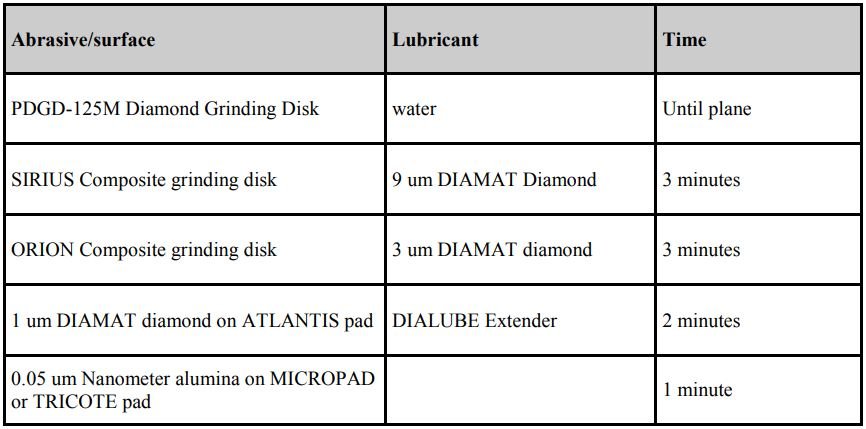

5.2 Stainless Steel
Stainless steels have high concentrations of chromium (>12%) and are generally relatively soft as compared to heat-treated steels. This makes stainless steel more susceptible to smearing. Preparation is relatively straight-forward.
| Abrasive/surface | Lubricant | Time |
| 320 grit SiC paper 400 grit SiC paper 600 grit SiC paper 800 grit SiC paper 1200 grit SiC paper | water | Until plane 1 minute 1 minute 1 minute 1 minute |
| 1 um DIAMAT diamond on TEXPAN pad | SIAMAT colloidal silica | 2 minutes |
| 0.05 um Nanometer alumina on NAPPAD pad | 1 minute |

5.3 Aluminum and Aluminum Alloys
Aluminum and aluminum alloys are difficult to prepare because they are soft and contain oxide particles which can become dislodged and scratch the surface. The key to polishing aluminum is to use very fine polishing abrasives (fine aggregates).
| Abrasive/surface | Lubricant | Time |
| P220 grit ALO paper P500 grit ALO paper P1200 grit ALO paper | water | Until plane 1 minute 1 minute |
| 1 um DIAMAT diamond on ATLANTIS pad | DIALUBE Purple Extender | 2 minutes |
| 0.05 um Nanometer alumina on NAPPAD pad | 1 minute |

5.4 Cast Iron
Cast irons are difficult materials to prepare properly because the graphite nodules (or graphite flakes)
are easily pulled out during preparation. By minimizing the sectioning damage and by starting with a modest-grit-size SiC paper, retaining these difficult particles can be accomplished.
| Abrasive/surface | Lubricant | Time |
| 320 grit SiC paper 400 grit SiC paper 600 grit SiC paper 800 grit SiC paper 1200 grit SiC paper | water | Until plane 1 minute 1 minute 1 minute 1 minute |
| 1 um DIAMAT diamond on GOLDPAD pad | DIALUBE Purple Extender | 3 minutes |
| 0.05 um Nanometer alumina on TRICOTE pad | 1 minute |

5.5 Alumina Ceramic
The preparation of hard / brittle / porous ceramic materials is not especially difficult when a few simple preparation tricks are known for this class of materials. First, to minimize grain pull-out (which may be falsely characterized as porosity), sectioning damage must be minimized. This is accomplished by sectioning with the appropriate diamond wafering blade and using the finest practical abrasive for initial grinding.
Planar grinding is best achieved with the use of the smallest diamond abrasive possible on a metal mesh cloth. Note that there is a trade-off between planar grinding time (abrasive size) and induced damage. In some cases for ceramics, it is better to take more time and minimize damage at planar grinding in order to reduce overall polishing times.
The use of SIAMAT™ colloidal silica also provides a chemical mechanical polishing (CMP) action, which is the most effective means for eliminating both surface and subsurface damage. The combination of SIAMAT™ colloidal silica with a DIAMAT™ polycrystalline diamond also produces excellent surface finishes.
| Abrasive/surface | Lubricant | Time |
| 30 um DIAMAT diamond on CERMESH metal mesh cloth | Until plane | |
| 6 um DIAMAT diamond on TEXPAN polishing pad | SIAMAT colloidal silica | 5 minutes |
| 1 um DIAMAT diamond on GOLDPAD polishing pad | SIAMAT colloidal silica | 5 minutes |
| SIAMAT Colloidal silica on TEXPAN pad | 5 minutes |
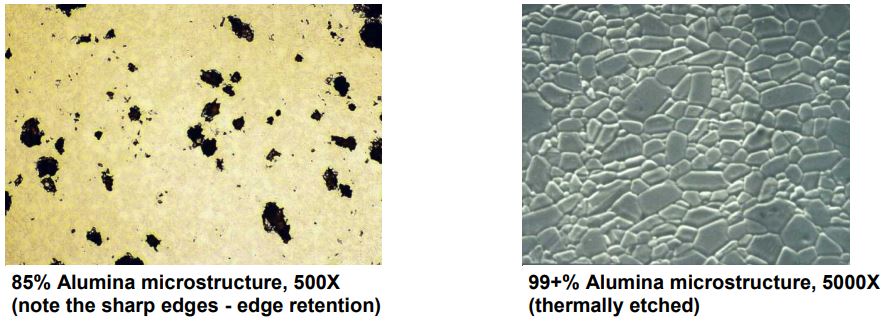
Educational Etchant and Procedure Database CD (optional)
- Etchant Database – OVER 2200 ETCHANTS
- Search Fields
• Material or metal type
• Specific alloys
• Etchant name
• Micro vs. Macro etchant
• Keyword - MSDS for Etchant Chemicals
- Preparation Guidelines
- Preparation Basics
- Preparation Trouble Shooting


Maintenance
1. Introduction
The NANO 1000T requires very minimal maintenance. However, to increase the life of the polisher, it is suggested that the unit be rinsed after use.
2. Cleaning outside cabinet
The cabinet should be cleaned occasionally with a moistened cloth. Do not use any chemicals or cleaning abrasives.
Trouble Shooting
More extensive trouble shooting, repair guides, video’s, parts list are provided online at www.metallographic.com or
http://www.metallographic.com/PACE-service/NANO-service.html
| Problem | Cause | Solution |
| No power or function |
|
|
| No water supply |
|
|
| Working wheel is not running plane (flat) |
|
|
| Error Message E1 |
|
|

Metallographic Consumables
1. SiC Abrasive Paper, Surface Roughness

3. Polishing Pads
 4. Polycrystalline Diamond Abrasives
4. Polycrystalline Diamond Abrasives
Polycrystalline diamond is a synthetic diamond which provides better surface finishes and higher removal rates than monocrystalline diamond. The following are the advantages of a polycrystalline diamond over a monocrystalline diamond:
- Higher removal rates (self-sharpening abrasive)
- Very uniform surface finish
- More uniform particle size distribution
- Harder / tougher particles
- Blocky – shaped particles
- Hexagonal (equally hard in all directions) micro crystallites
- Extremely rough surface (more cutting points)
- Surface area is 300% greater than with a monocrystalline diamond
- No abrasion-resistant directionality (abrasion independent of particle orientation)

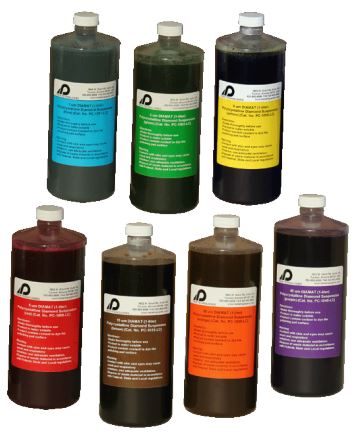
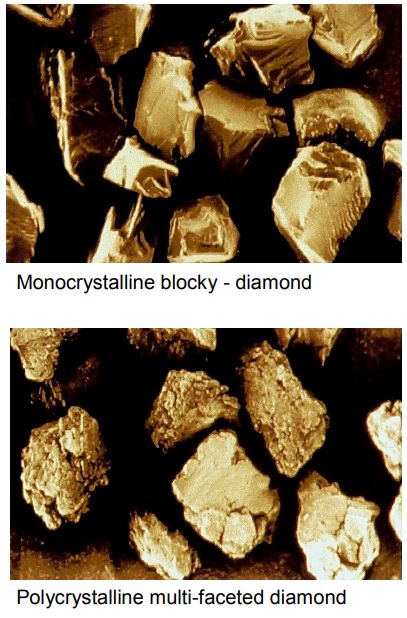
5. Final Polishing Abrasives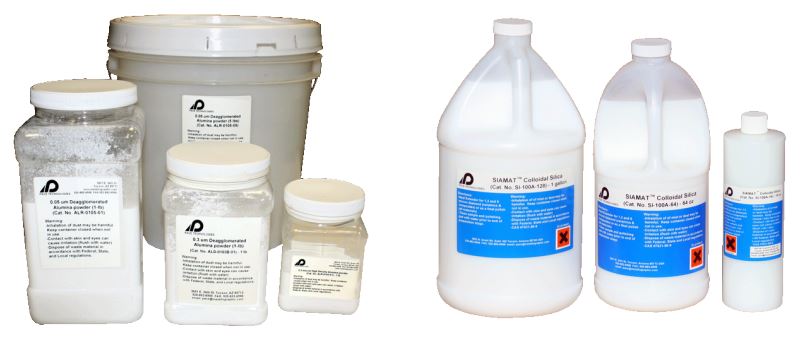 Final polishing abrasives include fine diamond, alumina and colloidal silica. For successful microstructural preparation, the polishing abrasive / cloth combination must be appropriately matched to the specimen hardness, fracture toughness and corrosion properties of the specimen.
Final polishing abrasives include fine diamond, alumina and colloidal silica. For successful microstructural preparation, the polishing abrasive / cloth combination must be appropriately matched to the specimen hardness, fracture toughness and corrosion properties of the specimen.
Colloidal Silica
Colloidal silica is a relatively soft abrasive with high chemical activity. It is an ideal chemical mechanical polishing (CMP) abrasive. The chemical activity of colloidal silica results from the electrochemical balance (zeta potential) required to keep very fine particles from aggregating. This chemical balance also produces a surface phenomenon which makes the specimen surface more chemically active. This produces a surface layer which can be mechanically removed by the colloidal silica particles themselves, or by the mechanical scrubbing of the surface with the polishing pad.
For ceramics, the combination of fine polycrystalline diamond and colloidal silica improves surface finishes and increases polishing rates.
Nanometer Alumina
Nanometer alumina is a polycrystalline colloidal alumina processed by a proprietary seeded gell process. Polycrystalline alumina offers two significant improvements over conventional alumina calcining processes:
- Tighter, more controlled particle size distributions
- Harder alpha alumina particles
The tighter, more controlled particle size distribution is a result of less particle aggregation which produces significantly less scratching in soft metals, such as aluminum, tin, lead, copper and soft steels.
Nanometer alumina is available in an acidic (pH 4) or basic (pH 10) range.
Spare Parts
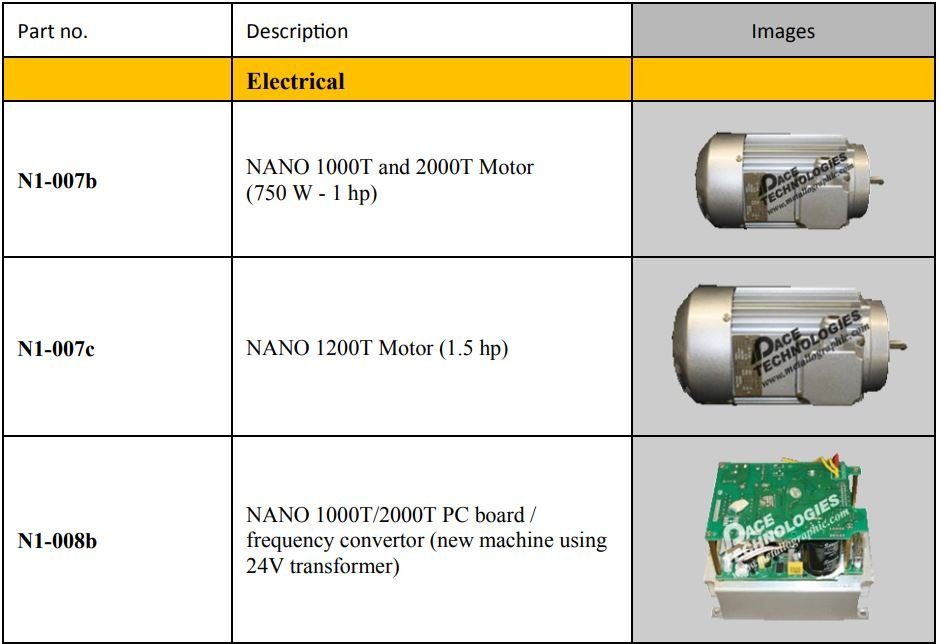











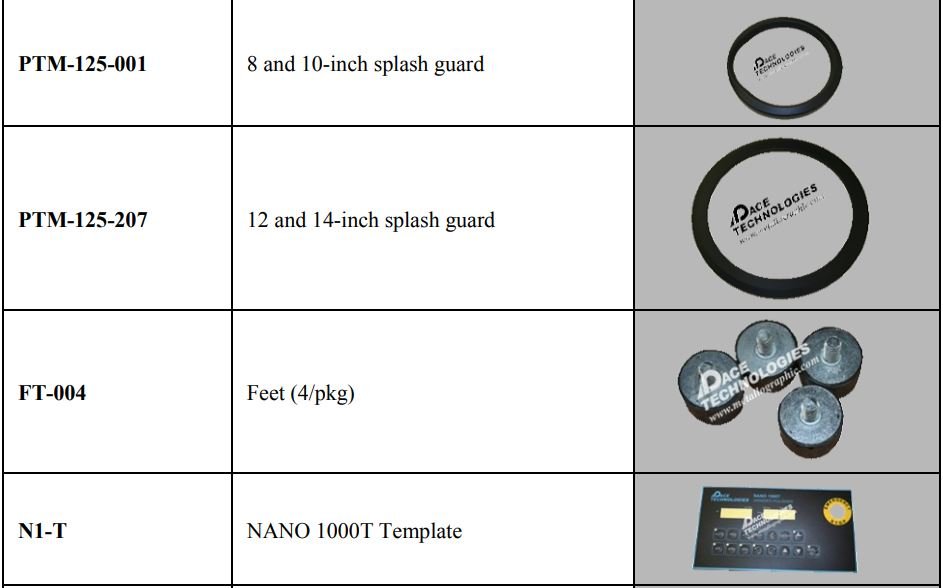

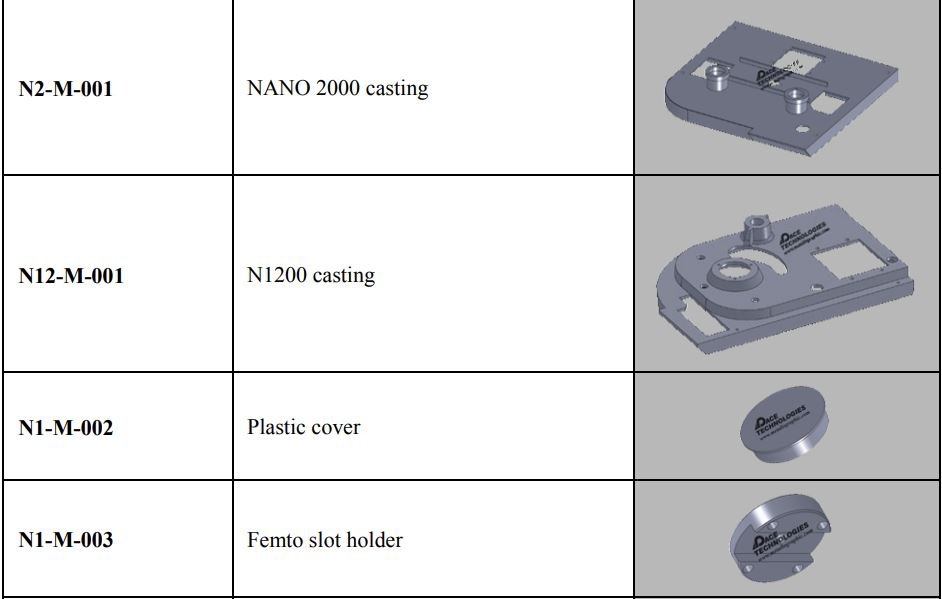









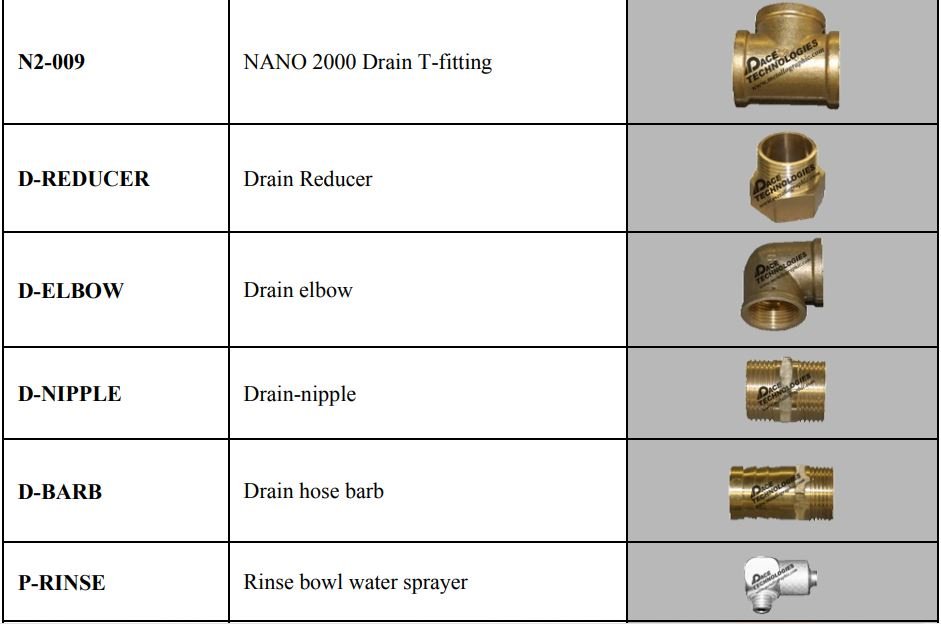

Schematics (NANO case assembly)


1. Schematics (NANO internal mechanical assembly)
 3. Electrical Schematic
3. Electrical Schematic 1. Full Programming Parameters
1. Full Programming Parameters
NANO 1000T/2000T and 1200T with 20 rpm increments (1 and 1.5 hp motor)
Note:
Do not start or run the motor before the correct input voltage is programmed;
RESET DEFAULT BEFORE REPROGRAMMING
Go to dF → Enter → -def → Enter
Steps to set converter input voltage and frequency response:
Go into Program “U” (Password:0253) → Enter → input “1001” →Enter → input “2020” → Enter → input “3030” →Enter→ input “4170” →Display “OVER” →Enter
Go into Program “U” (Password:0253) → Enter → input “1030” →Enter → input “2170” → Enter → input “3050” →Enter→ input “4255” →Display “OVER” →Enter
Go into Program “U” (Password:0253) → Enter → input “1050” →Enter → input “2225” → Enter → input “3120” →Enter→ input “4255” →Display “OVER” →Enter
2. Go into Program “nS” (Password:0253) → Enter → input “2” → Enter
3. Go into Program “Sr” (Password:0253) → Enter → input “1.4” → Enter
Steps to set converter input voltage and frequency response:
FOR 110V
Go into Program “U” (Password:0253) → Enter → input “1001” →Enter → input “2025” → Enter → input “3050” →Enter→ input “4255” →Display “OVER” →Enter
Go into Program “U” (Password:0253) → Enter → input “1050” →Enter → input “2255” → Enter → input “3120” →Enter→ input “4255” →Display “OVER” →Enter
FOR 220V
Go into Program “U” (Password:0253) → Enter → input “1001” →Enter → input “2025” → Enter → input “3050” →Enter→ input “4225” →Display “OVER” →Enter
Go into Program “U” (Password:0253) → Enter → input “1050” →Enter → input “2225” → Enter → input “3120” →Enter→ input “4225” →Display “OVER” →Enter
2. Go into Program “nS” (Password:0253) → Enter → input “2” → Enter
3. Go into Program “Sr” (Password:0253) → Enter → input “1.4” → Enter
NANO 1000T/2000T and 1200T with 20 rpm increments (1 and 1.5 hp motor)

NANO 1000T/2000T and 1200T with 1 rpm increments (1 and 1.5 hp motor)
Note:
Do not start or run the motor before the correct input voltage is programmed;
RESET DEFAULT BEFORE REPROGRAMMING
Go to dF → Enter → -def → Enter
Steps to set converter input voltage and frequency response:
Go into Program “U” (Password:0253) → Enter → input “1001” →Enter → input “2042” → Enter → input “3050” →Enter→ input “4255” →Display “OVER” →Enter
Go into Program “U” (Password:0253) → Enter → input “1050” →Enter → input “2225” → Enter → input “3120” →Enter→ input “4255” →Display “OVER” →Enter
2. Go into Program “nS” (Password:0253) → Enter → input “2” → Enter
3. Go into Program “Sr” (Password:0253) → Enter → input “1.4” → Enter
NOTE: If any of the numbers are entered incorrectly in the above sequence, the process requires that the default be reset and the program the sequence entered again until it is exactly correct. THIS IS VERY CRITICAL OTHER WISE AN E01 ERROR CAN OCCUR.
Steps to set converter input voltage and frequency response:
The above settings are for maximum torque which will result is a slight vibration between 240- 280 rpm, to reduce the vibration at the slight loose of torque rest these parameters:
Go into Program “U” (Password:0253) → Enter → input “1001” →Enter → input “2040” → Enter → input “3011” →Enter→ input “4050” →Display “OVER” →Enter
Go into Program “U” (Password:0253) → Enter → input “1011” →Enter → input “2050” → Enter → input “3014” →Enter→ input “4050” →Display “OVER” →Enter
Go into Program “U” (Password:0253) → Enter → input “1014” →Enter → input “2050” → Enter → input “3050” →Enter→ input “4225” →Display “OVER” →Enter
2. Go into Program “nS” (Password:0253) → Enter → input “2” → Enter
3. Go into Program “Sr” (Password:0253) → Enter → input “1.4” → Enter
NANO 1000T/2000T and 1200T with 1 rpm increments (1 and 1.5 hp motor)

Download Manual PDF
MEEC TOOLS POLISHING MACHINE 1100 W
User Manual PDF Download






